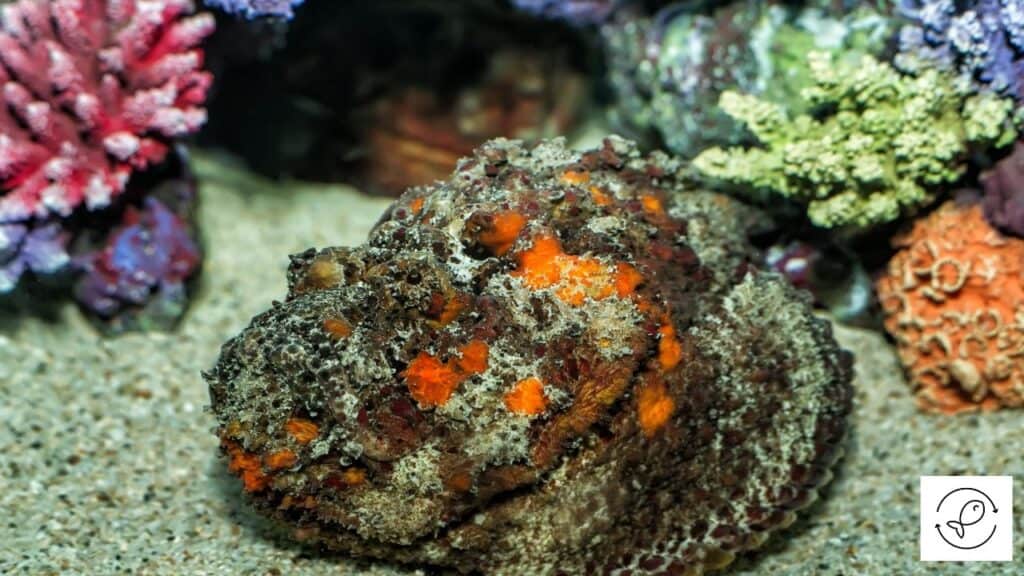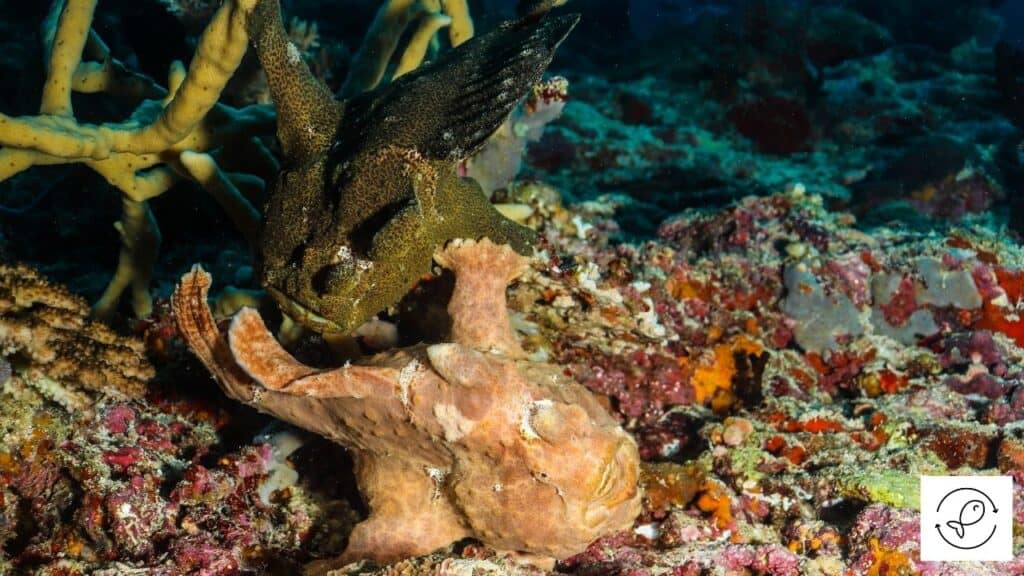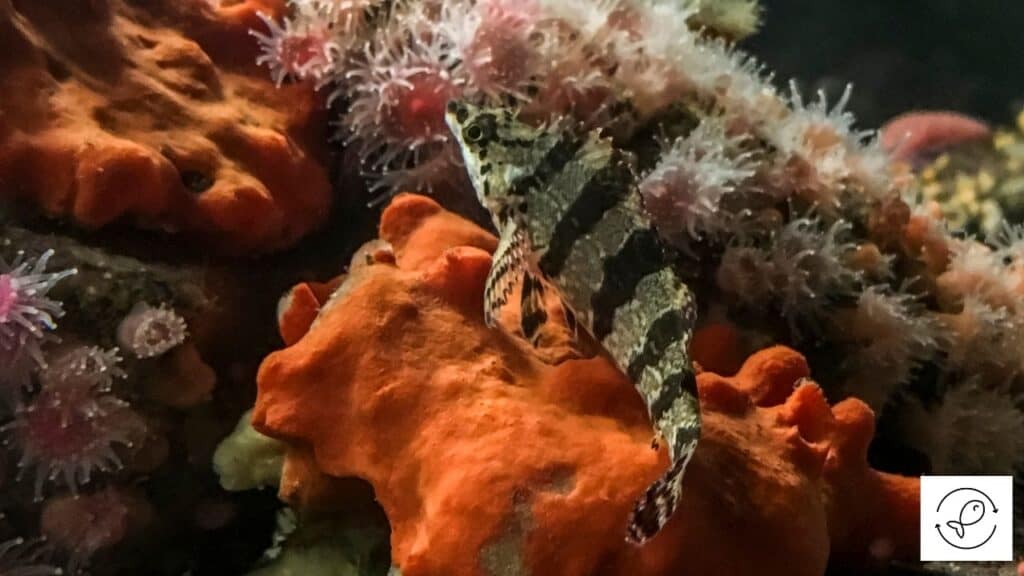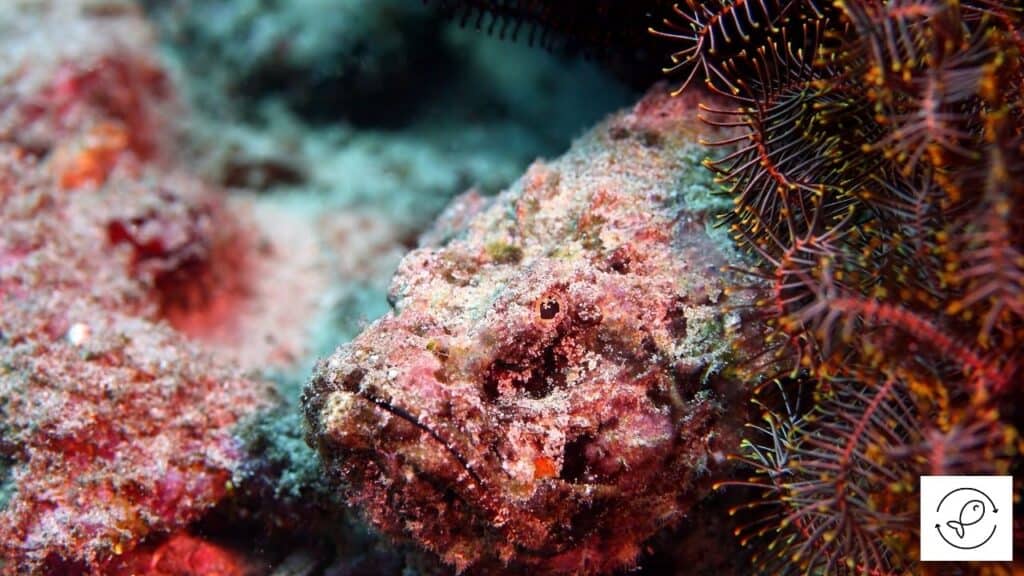Fish are amazing creatures. They are beautiful and full of life. However, there are certain fish that look like rocks.
These fish are often mistaken for natural rocks because of their coloration.
Here are three fish that look like rocks:
- Stonefish,
- Frogfish, and
- Fourspine Sculpin.
Let’s take a detailed look at each of these fish now.
3 Fish That Look Like Rocks
While there are quite a few fish that look unique, here are three fish that look like rocks.
1. Stonefish

Stonefish belong to the genus Synanceia of the family Synanceiidae.
They are usually found in the marine waters of the Indo-Pacific region, where the water bodies are rocky and muddy.
These fish are called “Stonefish” because their bodies are textured to resemble the rocks or corals in their natural habitat.
They usually have orange, yellow, and red patches, which form help them camouflage themselves with their surroundings.
Stonefish are highly venomous.
They have thirteen needle-like spines on their dorsal fin that pop out and release venom if you step on these fish.
So if you get stung by a stonefish, you will have to bear terrible pain, swelling, and it can even be fatal to you.
Luckily, there haven’t been too many fatalities because of stonefish stung.
However, you have to get immediate medical attention to cure the adverse effects of its venom.
In summary, here are some key takeaways:
- These fish are very venomous and should never be handled.
- You can tell it’s a stonefish by looking at its dorsal fin. It has 13 spines.
- You should never step on a stonefish.
2. Frogfish

Frogfish belong to the genus Antennarius of the family Antennariidae.
They are found all around the world in shallow tropical waters.
These fish are small and lumpy, with large mouths and spiky skin. The largest frogfish species grows to around 12 inches (20 cm) long.
These fish are called frogfish because they resemble a frog as their pectoral fins look like legs, which literally help them walk on the ocean floor.
However, unlike stonefish, frogfish are not poisonous at all. And they are only around 1/8 inch to 22 inches long.
They usually take on the colors of their surroundings, similar to a chameleon for blending in with the background.
Some species of frogfish even have textured skin matching the reef surface.
Thus these fish are able to camouflage themselves as rocks or sponges.
This way, they hide from predators as well as catch their unsuspecting prey.
In summary, here are some key takeaways:
- Frogfish are not poisonous.
- They are only around 1/8 inch to 22 inches long.
- They are masters at camouflaging themselves as rocks to protect themselves from predators and catch prey.
3. Fourspine Sculpin

Fourspine Sculpin belongs to the genus Rheopresbe of the family Cottidae. This fish is endemic to Japan.
Fourspine Sculpins have large mouths, pectoral and dorsal fins, and can grow to a maximum length of 11.8 inches (30 cm).
They have teeth on palatines and four spines on the preopercle ridges.
Similar to stonefish and frogfish, fourspine sculpins are also masters of camouflaging themselves as rocks to protect themselves from predators and catch prey.
Unfortunately, the population of these fish has decreased.
And so, various efforts are underway to create an efficient culture system for the fourspine sculpins.
In summary, here are some key takeaways:
- Fourspine Sculpins are endemic to Japan.
- They camouflage themselves as rocks to protect themselves from predators and catch prey.
- The population of these fish is decreasing.
What’s Interesting About Having Fish In Your Aquarium That Look Like Rocks?
Having fish that look like rocks makes your aquarium more exciting and fun.
You don’t need to buy expensive decorations for your tank anymore. Just add some rock-like fishes to it.
This not only adds beauty to an aquarium, but it also helps in giving a natural look to it.
Moreover, not many aquarists keep such fish in their aquarium. So having them in yours will make your aquarium stand out.
But remember, don’t feed them unless you know what type of food they prefer.
These fish need a lot of care and attention, which is not always possible if you are a beginner aquarist.
Which One Of These Fish Should You Get?
While you can think of having stonefish for yourself, remember that this fish is highly poisonous.
So it’s better to avoid having this fish. Even if you accidentally step on this fish, it can be fatal.
Frogfish are probably the best choice among these fish to keep.
But you will have to take care of their feeding as they are used to capturing their food by camouflaging themselves.
They are not your typical top or bottom feeders.
Fourspine Sculpin population is already dwindling.
So it’s better to avoid this fish unless you know very well how to take care of such fish and breed them in numbers.
If possible, avoid getting any of these fish as they are more suited to their natural habitat.
While you may love the idea of having fish that look like rocks in your aquarium, it’s better to stick to those that are native to your region.
Related Questions
What happens if you step on a stonefish?
If you step on a stonefish, it will pop out its spines on its dorsal fins and inject venom into you.
This venom can be fatal to you if you don’t get immediate medical attention.
Can you survive a stonefish?
Yes, you can survive a stonefish venom if you get immediate medical attention.
However, if immediate medical treatment is not provided, the stonefish venom can be fatal.
Can you have frogfish as a pet?
Yes, you can have frogfish as a pet.
However, you will need to provide them with suitable tank conditions and feed them properly.
Proper habitat and appropriate food can help frogfish have a healthy and long life in captivity.

